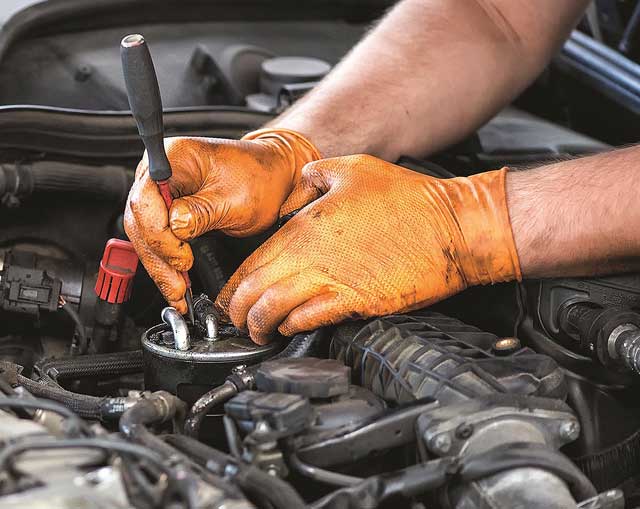
Exposure to industrial chemicals remains a hazard that workers must remain vigilant about – especially for the hands. John Lambeth, technical manager of single use glove specialist Unigloves, looks at the dangers.
Hands exposed to chemicals on a regular basis are stripped of their natural protective oils. Eventually the skin will lose its ability to repair itself, leading to skin diseases such as dermatitis, urticaria and, in severe cases, skin cancer.
According to the Health and Safety Executive, an estimated 7,000 new cases of self-reported work-related skin problems are recorded annually in the UK
Workers in the maintenance and engineering sectors are in one of the higher-risk environments for exposure, given the substances commonly used, including oils, greases, de-greasing fluids and metalworking fluids.
Even just having wet hands for long periods will strip the skin of its natural protective oils, greatly increasing the risk of skin disease if this continues unchecked.
Where any skin hazards exist in the workplace, the first step should always be to seek to change working practices to eliminate human contact wherever possible. But in reality this may not be practical or possible. In this case, selecting the right gloves to protect against the chemicals being encountered is essential.
Chronic condition
Most irritant contact dermatitis is chronic. Repeated exposure to many different irritants may result in an accumulation of damage to the skin’s cells. The damage is invisible until the point is reached where the skin finally breaks down and dermatitis appears, with symptoms including itchy, burning, red, sore and cracked skin. By then the damage is done. Though the symptoms can be treated, any further exposure to the irritants in question is likely to trigger another flare-up.
Where it has been extablished that protective gloves are required, key steps should include:
- Providing appropriate protective clothing or gloves
- Making sure gloves are made of suitable materials for the chemicals encountered
- Selecting gloves that are the right size and right protection for the task being done
- Replacing gloves when necessary
- Supplying moisturising pre-work and after-work creams.
Employers should also make sure regular skin checks are carried out to look for the early onset of skin disease.
Selecting the right gloves
When you select protective gloves, base your choice on the work, the wearer and the environment they work in. You will need to identify the substances handled, as well as all other hazards. Consider the type and duration of contact the worker will have – for example, are the gloves being splashed by or immersed in the chemical? You also need to take into account the comfort of the user and the task they are engaged in.
No glove material will protect against all substances, and no gloves will protect against a specific substance forever, so it’s vital to know what workers are in contact with.
EN Standards for gloves
EN 374-2: tests for defects in the glove such as holes and seams, using a water leak and an air inflation test.
EN 16523-1 (formerly EN374-3): tests for permeation of chemicals through the glove by totally immersing it in the chemical.
EN374-4: tests for loss of strength in the glove when exposed to a chemical.
You will also need to consider whether there are any other risks, such as mechanical hazards from machinery increasing the likelihood of scuffing, snagging, grazes and cuts – and make sure the glove selected can protect against these to the right level.
Glove materials such as Nitrile provide a good balance of chemical protection with strength and high levels of comfort. Glove manufacturers such as Unigloves provide information on how well their gloves perform against different substances. For protection you need to consider three key terms:
- Breakthrough time: This is the time a chemical will take to permeate through the glove material to the inside (without going through pinholes, pores or other visible openings). This tells you how long you can use a glove for.
- Permeation rate: the amount that permeates through. The higher the rate, the more of the chemical will move through the glove.
- Some chemicals can destroy the glove material. It may get harder or softer, or it may swell. This is known as degradation.
Comfort and grip
Gloves should not hamper the task. If wet or oily objects are handled, choose gloves with a roughened or textured surface for good grip.
Gloves that are not completely comfortable are more likely to be taken off during a shift. Get samples of the gloves you’ve identified and see if workers find them comfortable. It is also important that gloves fit properly, so make sure you provide the right size for each worker.
Get support
If you are in any doubt, seek the support and advice of a glove manufacturer such as Unigloves, who will help you select the right glove through a glove audit and free samples.
To find out more visit info.unigloves.co.uk/request-a-sample, call Unigloves on 0800 049 6602 or email enquiries@unigloves.co.uk or technical@unigloves.co.uk

